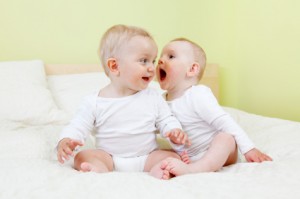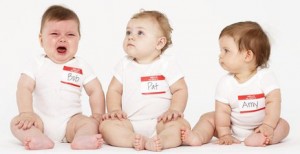So I was sitting in the library the other day trying to think of topics for my blogs, and I just couldn’t think of anything. I had no idea what would make a good topic but then I thought about something funny that I encountered last year. I was hanging out with my friend at her grandmother’s house and all her cousins were there, mind you they are all very young. We had to watch them while they played outside. Two of her cousins were maybe a few months old and we had them stay with us on the porch. Anyway these two little girls started having this whole conversation, and normally that wouldn’t be anything to laugh about, except for the fact that they didn’t really know how to speak. So me and my friend are just sitting there staring in astoundment at the fact that these two girls are having a whole conversation without actually ever saying a coherent word. As I sat in the library thinking about this experience I wondered if it were possible that babies could really even speak to one another? I wondered was it possible that they had their own language that only they could understand and so I decide to do some research and make this one of my blog topics.

From my research I found that to a certain extent babies can communicate with one another. The only catch is that when they are babbling to one another it not actually secret baby words they understand but each other’s emotions or moods. In the Psychology journal Infancy, Mariana Vaillant-Molina, Lorraine E. Bahrick, and Ross Flom wrote an article on how babies use facial expression and vocal inflection of other babies to understand each other’s moods. Flom and his co-writers expressed how it is common knowledge that babies can perceive the emotions of adults however they further researched whether the same was such for infant to infant communications. At the end of the study they found that babies four months of age could in fact match certain vocal inflections (positive and negative) with their adjacent facial expressions. Furthermore the amount of emotions they could perceive increased greatly as they grew older; up to about the age of 7 month when which they can perceive a vast variety of moods or emotions. Also babies four months old cloud pick up on emotion through video, but not a still image and recording separate from one another.

In the study there were 59 participants 19 of them were excluded from the result due to various reasons and the rest were equal divide between three and a half months and five months old babies. These baby viewed the facial expression and listen to the voice of infants seven and a half months old and eight months old. The images and audio used for the study was from thirty different infant however what was used was the eight best representation of positive and negative emotions (two for each emotion). This result in different vocalization and facial expression for each mood simulation. All infant on the screen wore the same thing with the same background allowing only their face to be seen and each video was roughly ten seconds. The controls in place for the participants included seating them all the same distant from the monitor. A video feed placed above the monitor allowed an observer to record the time frame in which the baby’s face was fixed on the monitor. The infants on the on the monitors were randomly selected so that each baby watch saw one out of the two video for each emotion. The audio would play and two photos would appear this was done in twelve trial which were divided into two blocks. Observers saw how long it took the babies to fixate on the image that correlated with the correct recording.

So flom found something really interesting, but I wonder did he use good siente to find his answer. I would like to review the steps of his study order to find this information. One thing that would make his study more convincing is if there were a meta-analysis; it is concerning that he only used 59 participant, 19 of which he did not use, it makes me wonder if the result would have been different if the study was larger or if there were just more of them. I will however motion that Flom’s study was a randomized single blind study; I believe the babies were randomly distributed and the observers that timed them could not see the screen. With these controls in place it is less Ike to have bias results. The observers not seeing the monitor stop them from reacting when they match the video to the voices versus when the babies do. I am concerned that while the babies were randomized they took 19 of them out of the study. This puts into question if the Texas sharpshooter problem is an issue in this study. You can not select which babies to keep in the study and which not to. They said they were taken out of the study because of excessive fussiness, but what if their fussiness affected the results of the study; perhaps they were outliers excluded because of their responses. There were controls put in place for this study but I really have to wonder if Flom suffered from a bit of confirmation bias. The last thing I would like to make a remark on is is the fact that the babies watching the video and those in the video were different ages and I wonder still if babies have to see older babies to understand their moods or if the can understand those emotions of their peers.

It makes you wonder how much of the formation of out social construct comes from out interaction with other babies.
Ahhh I love this blog, so cute. It caught my eye right away. This is actually such an interesting subject to think about. That is a really cool study. I find it interesting how they could recognize the emotions and moods of other but I wish there were more things they were testing, almost like if one child said a word to another, if that kid would know what that word was. I wish there were more live links in this post and more resources so I could follow along easier and learn more about this interesting question. I do really like how you related it to the Texas sharpshooter problem! Heres how babies are communicating: http://www.webmd.com/parenting/baby/infant-development-9/baby-talk !
I have always wondered the same question myself which is why I was initially drawn to your post. The results of this study proved to pose an interesting question. What exactly about the five month mark allows babies to learn and react to emotional cues given to by other babies? Or is this yet to be discovered?